Fen Fang
Team I2R-VI-FF Technical Report on EPIC-KITCHENS VISOR Hand Object Segmentation Challenge 2023
Oct 31, 2023Abstract:In this report, we present our approach to the EPIC-KITCHENS VISOR Hand Object Segmentation Challenge, which focuses on the estimation of the relation between the hands and the objects given a single frame as input. The EPIC-KITCHENS VISOR dataset provides pixel-wise annotations and serves as a benchmark for hand and active object segmentation in egocentric video. Our approach combines the baseline method, i.e., Point-based Rendering (PointRend) and the Segment Anything Model (SAM), aiming to enhance the accuracy of hand and object segmentation outcomes, while also minimizing instances of missed detection. We leverage accurate hand segmentation maps obtained from the baseline method to extract more precise hand and in-contact object segments. We utilize the class-agnostic segmentation provided by SAM and apply specific hand-crafted constraints to enhance the results. In cases where the baseline model misses the detection of hands or objects, we re-train an object detector on the training set to enhance the detection accuracy. The detected hand and in-contact object bounding boxes are then used as prompts to extract their respective segments from the output of SAM. By effectively combining the strengths of existing methods and applying our refinements, our submission achieved the 1st place in terms of evaluation criteria in the VISOR HOS Challenge.
Masked Diffusion with Task-awareness for Procedure Planning in Instructional Videos
Sep 14, 2023Abstract:A key challenge with procedure planning in instructional videos lies in how to handle a large decision space consisting of a multitude of action types that belong to various tasks. To understand real-world video content, an AI agent must proficiently discern these action types (e.g., pour milk, pour water, open lid, close lid, etc.) based on brief visual observation. Moreover, it must adeptly capture the intricate semantic relation of the action types and task goals, along with the variable action sequences. Recently, notable progress has been made via the integration of diffusion models and visual representation learning to address the challenge. However, existing models employ rudimentary mechanisms to utilize task information to manage the decision space. To overcome this limitation, we introduce a simple yet effective enhancement - a masked diffusion model. The introduced mask acts akin to a task-oriented attention filter, enabling the diffusion/denoising process to concentrate on a subset of action types. Furthermore, to bolster the accuracy of task classification, we harness more potent visual representation learning techniques. In particular, we learn a joint visual-text embedding, where a text embedding is generated by prompting a pre-trained vision-language model to focus on human actions. We evaluate the method on three public datasets and achieve state-of-the-art performance on multiple metrics. Code is available at https://github.com/ffzzy840304/Masked-PDPP.
A Study on Differentiable Logic and LLMs for EPIC-KITCHENS-100 Unsupervised Domain Adaptation Challenge for Action Recognition 2023
Jul 13, 2023Abstract:In this technical report, we present our findings from a study conducted on the EPIC-KITCHENS-100 Unsupervised Domain Adaptation task for Action Recognition. Our research focuses on the innovative application of a differentiable logic loss in the training to leverage the co-occurrence relations between verb and noun, as well as the pre-trained Large Language Models (LLMs) to generate the logic rules for the adaptation to unseen action labels. Specifically, the model's predictions are treated as the truth assignment of a co-occurrence logic formula to compute the logic loss, which measures the consistency between the predictions and the logic constraints. By using the verb-noun co-occurrence matrix generated from the dataset, we observe a moderate improvement in model performance compared to our baseline framework. To further enhance the model's adaptability to novel action labels, we experiment with rules generated using GPT-3.5, which leads to a slight decrease in performance. These findings shed light on the potential and challenges of incorporating differentiable logic and LLMs for knowledge extraction in unsupervised domain adaptation for action recognition. Our final submission (entitled `NS-LLM') achieved the first place in terms of top-1 action recognition accuracy.
Team VI-I2R Technical Report on EPIC-KITCHENS-100 Unsupervised Domain Adaptation Challenge for Action Recognition 2022
Jan 29, 2023



Abstract:In this report, we present the technical details of our submission to the EPIC-KITCHENS-100 Unsupervised Domain Adaptation (UDA) Challenge for Action Recognition 2022. This task aims to adapt an action recognition model trained on a labeled source domain to an unlabeled target domain. To achieve this goal, we propose an action-aware domain adaptation framework that leverages the prior knowledge induced from the action recognition task during the adaptation. Specifically, we disentangle the source features into action-relevant features and action-irrelevant features using the learned action classifier and then align the target features with the action-relevant features. To further improve the action prediction performance, we exploit the verb-noun co-occurrence matrix to constrain and refine the action predictions. Our final submission achieved the first place in terms of top-1 action recognition accuracy.
Visuo-Tactile Manipulation Planning Using Reinforcement Learning with Affordance Representation
Jul 14, 2022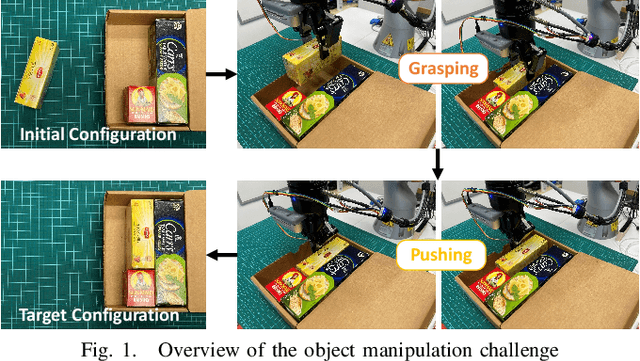
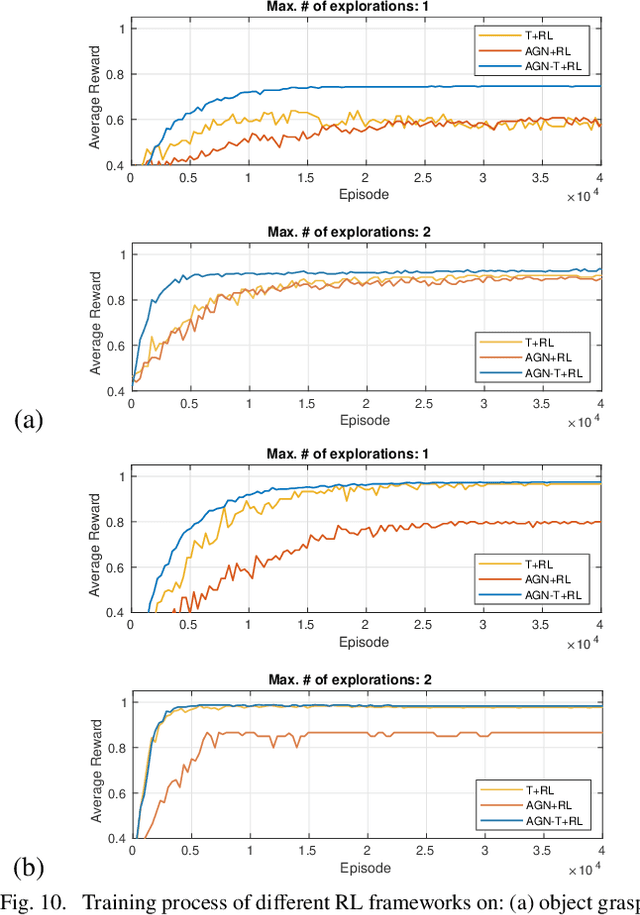
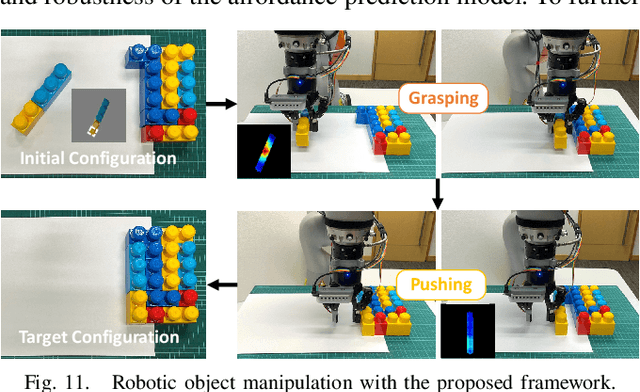
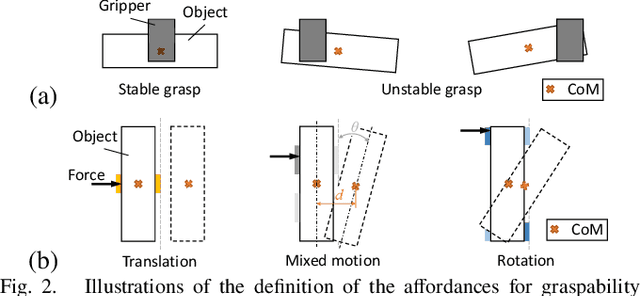
Abstract:Robots are increasingly expected to manipulate objects in ever more unstructured environments where the object properties have high perceptual uncertainty from any single sensory modality. This directly impacts successful object manipulation. In this work, we propose a reinforcement learning-based motion planning framework for object manipulation which makes use of both on-the-fly multisensory feedback and a learned attention-guided deep affordance model as perceptual states. The affordance model is learned from multiple sensory modalities, including vision and touch (tactile and force/torque), which is designed to predict and indicate the manipulable regions of multiple affordances (i.e., graspability and pushability) for objects with similar appearances but different intrinsic properties (e.g., mass distribution). A DQN-based deep reinforcement learning algorithm is then trained to select the optimal action for successful object manipulation. To validate the performance of the proposed framework, our method is evaluated and benchmarked using both an open dataset and our collected dataset. The results show that the proposed method and overall framework outperform existing methods and achieve better accuracy and higher efficiency.
Team VI-I2R Technical Report on EPIC-KITCHENS-100 Unsupervised Domain Adaptation Challenge for Action Recognition 2021
Jun 03, 2022



Abstract:In this report, we present the technical details of our approach to the EPIC-KITCHENS-100 Unsupervised Domain Adaptation (UDA) Challenge for Action Recognition. The EPIC-KITCHENS-100 dataset consists of daily kitchen activities focusing on the interaction between human hands and their surrounding objects. It is very challenging to accurately recognize these fine-grained activities, due to the presence of distracting objects and visually similar action classes, especially in the unlabelled target domain. Based on an existing method for video domain adaptation, i.e., TA3N, we propose to learn hand-centric features by leveraging the hand bounding box information for UDA on fine-grained action recognition. This helps reduce the distraction from background as well as facilitate the learning of domain-invariant features. To achieve high quality hand localization, we adopt an uncertainty-aware domain adaptation network, i.e., MEAA, to train a domain-adaptive hand detector, which only uses very limited hand bounding box annotations in the source domain but can generalize well to the unlabelled target domain. Our submission achieved the 1st place in terms of top-1 action recognition accuracy, using only RGB and optical flow modalities as input.
TAILOR: Teaching with Active and Incremental Learning for Object Registration
May 24, 2022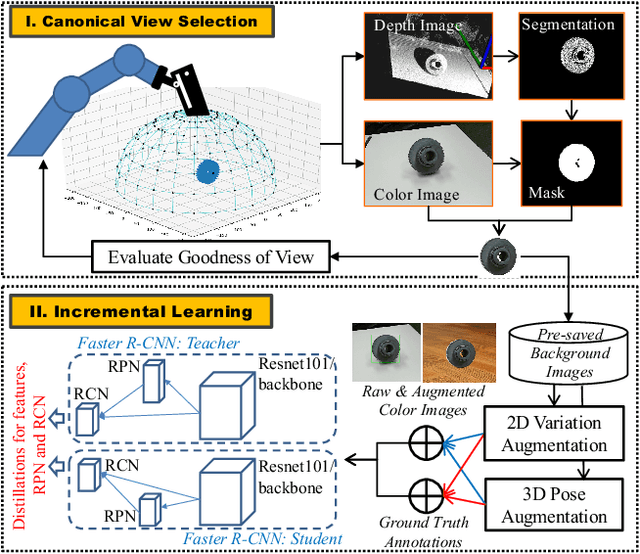

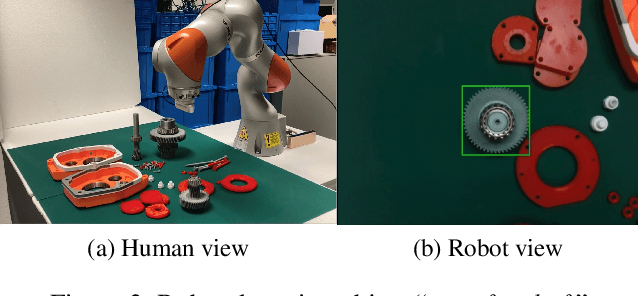
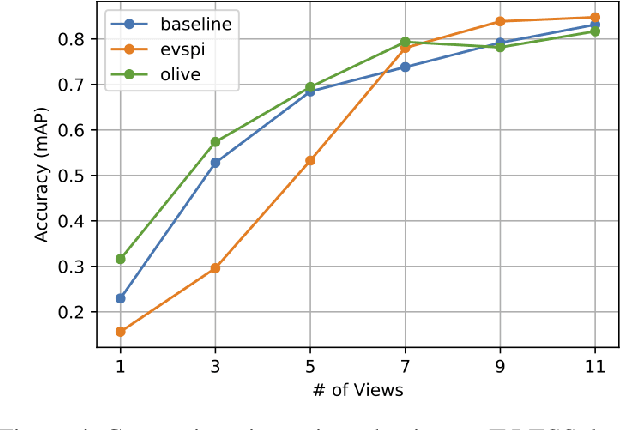
Abstract:When deploying a robot to a new task, one often has to train it to detect novel objects, which is time-consuming and labor-intensive. We present TAILOR -- a method and system for object registration with active and incremental learning. When instructed by a human teacher to register an object, TAILOR is able to automatically select viewpoints to capture informative images by actively exploring viewpoints, and employs a fast incremental learning algorithm to learn new objects without potential forgetting of previously learned objects. We demonstrate the effectiveness of our method with a KUKA robot to learn novel objects used in a real-world gearbox assembly task through natural interactions.
 Add to Chrome
Add to Chrome Add to Firefox
Add to Firefox Add to Edge
Add to Edge